HOTELS
IN PETRA JORDAN - PETRA JORDAN HOTELS - فنادق في بترا الأردن
DISCOUNT
UP TO 70%
|
NEW STEPS Travel & Tourism
Licensed by
the Ministry of Tourism
Phone: + 961 4 713 467
Phone: + 961 4 716 649 Phone:
+ 961 4 716 467
E-mail:
[email protected]
|
Hotels Reservation in Petra, Jordan
Book now, pay on check out
اللغة العربية
version fran�aise
For phone booking or last minute booking,
please call:
00961 4 713 467 ou 00961 4 716 467
ou 00961 4 716 649
 You can reserve rooms in any of the
Hotels below,
just click on the hotel for full listings with description and pictures and then
send us an e-mail with details of your booking.
You can reserve rooms in any of the
Hotels below,
just click on the hotel for full listings with description and pictures and then
send us an e-mail with details of your booking.

We've reduced our 2012 prices. Click on each hotel for details.
|
Hotels 5* in Petra |
|
Marriott Hotel 5*
 The Petra Marriott
Hotel is
situated
on a steep sloping site overlooking the dramatic and picturesque Petra
valley...........From
130$ per room.......
(more
details and special rates) The Petra Marriott
Hotel is
situated
on a steep sloping site overlooking the dramatic and picturesque Petra
valley...........From
130$ per room.......
(more
details and special rates)
|
Movenpick Resort Petra 5*
 The M�venpick Resort is located
directly at the entrance to the city of Petra. Easily reached by bus or car
from Amman or Aqaba. The hotel has 183 rooms (including 2 royal suites, 4
executive suites and..........From
145$ per room................(more
details and special rates) The M�venpick Resort is located
directly at the entrance to the city of Petra. Easily reached by bus or car
from Amman or Aqaba. The hotel has 183 rooms (including 2 royal suites, 4
executive suites and..........From
145$ per room................(more
details and special rates)
|
Taybet Zaman
Village 5*
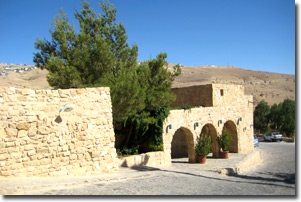 An authentic
early Jordanian
village houses; 130 guest houses and a royal suite, all with private bathrooms,
air conditioned and heated and tastefully furnished to compliment the village
style and setting. All rooms will feature satellite TV, direct dial telephone,
mini-bar; hairdryers, and room safes........From
100$ per room.........(more
details and special rates) An authentic
early Jordanian
village houses; 130 guest houses and a royal suite, all with private bathrooms,
air conditioned and heated and tastefully furnished to compliment the village
style and setting. All rooms will feature satellite TV, direct dial telephone,
mini-bar; hairdryers, and room safes........From
100$ per room.........(more
details and special rates) |
Beit Zaman Hotel 5*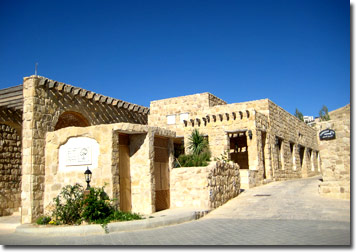 Grand Mercure Petra Beit Zaman, opened September, 2000, is a
renovated authentic XIXth century village, known as Khirbet Al Nawafleh, in Wadi
Musa, transformed into this deluxe resort.
The refurbishment of the old village houses was carried out in keeping with the
original architectural style while providing the luxury and comfort required by
the modern travelers...From
100$ per room..........(more
details and special rates) Grand Mercure Petra Beit Zaman, opened September, 2000, is a
renovated authentic XIXth century village, known as Khirbet Al Nawafleh, in Wadi
Musa, transformed into this deluxe resort.
The refurbishment of the old village houses was carried out in keeping with the
original architectural style while providing the luxury and comfort required by
the modern travelers...From
100$ per room..........(more
details and special rates) |
Movenpick Nabatean Castle Hotel 5*
Located
 on a
hillside at 1400 meter altitude, with spectacular view over the great rift
valley. 10 minutes from the entrance of city of Petra, the capital of
ancient Nabateans is a world treasure, Petra is a marriage of natural and
man-made wonders on an awsome scale, an entire city was carved out of the
highly-colored mountains .........From
100$ per room.........(more
details and special rates) on a
hillside at 1400 meter altitude, with spectacular view over the great rift
valley. 10 minutes from the entrance of city of Petra, the capital of
ancient Nabateans is a world treasure, Petra is a marriage of natural and
man-made wonders on an awsome scale, an entire city was carved out of the
highly-colored mountains .........From
100$ per room.........(more
details and special rates) |
Crowne Plaza Petra Hotel
5*
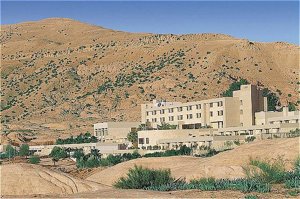 Situated just 100
meters
from the gateway to Petra, the Crown Plaza is the perfect place from which
to explore this ancient Nabatean capital. Set in landscaped grounds with
panoramic views over the mountains, the Petra Forum offers visitors
excellent facilities, comfort and unmatched hospitality.........From
115$ per room.........(more
details and special rates) Situated just 100
meters
from the gateway to Petra, the Crown Plaza is the perfect place from which
to explore this ancient Nabatean capital. Set in landscaped grounds with
panoramic views over the mountains, the Petra Forum offers visitors
excellent facilities, comfort and unmatched hospitality.........From
115$ per room.........(more
details and special rates) |
|
Hotels 4* in Petra |
Grand View Hotel
4*
Grand View Resort is a 5-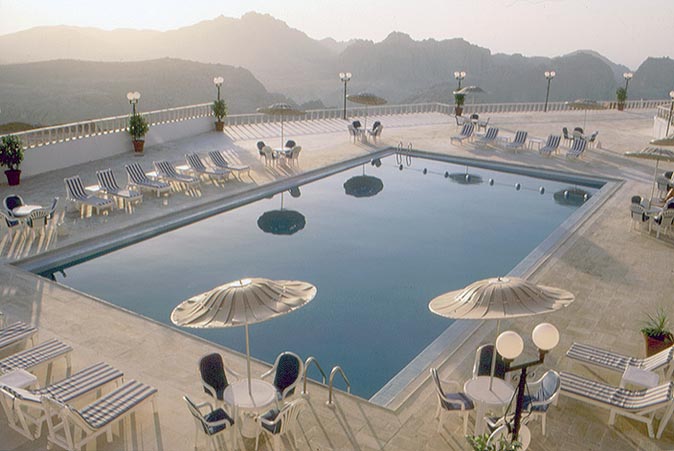 star hotel in Petra - Jordan,
offering an incomparable birds eye-view of the marvelous rock-carved rose red
city of Petra and the fascinating landscape surrounding it. Located at the mountain peak with cliff-top view of
this magical and mystical place, directly facing Mount Hor with a spectacular
view of Aaron�s Tomb, makes staying here truly an unforgettable once in a life
time experience.........From
100$ per room..........(more
details and special rates) star hotel in Petra - Jordan,
offering an incomparable birds eye-view of the marvelous rock-carved rose red
city of Petra and the fascinating landscape surrounding it. Located at the mountain peak with cliff-top view of
this magical and mystical place, directly facing Mount Hor with a spectacular
view of Aaron�s Tomb, makes staying here truly an unforgettable once in a life
time experience.........From
100$ per room..........(more
details and special rates) |
Petra Panorama Hotel 4*
The Panorama hotel
 is situated
on a hill overlooking Petra with breathtaking views of mountain, plain and sea,
only 5 minutes drive from the entrance to the ancient city of Petra. Located
just 200 meters from the resort centre of Petra means guests are within easy
reach of all amenities........From
95$ per room.......(more
details and special rates) is situated
on a hill overlooking Petra with breathtaking views of mountain, plain and sea,
only 5 minutes drive from the entrance to the ancient city of Petra. Located
just 200 meters from the resort centre of Petra means guests are within easy
reach of all amenities........From
95$ per room.......(more
details and special rates) |
Kings Way Golden Tulip
Hotel 4*
 Welcome to
the heart of one of
the ancient civilizations in the land of Jordan, within the Kings' Highway,
inhabited by numerous empires for several thousands of years. The Golden Tulip
Kings' Way is located next to the famous Moses Springs, 4 km from the
amazing rose-red city of Petra. A modern 4-Star hotel, we are equipped
with..........From
125$ per room........(more
details and special rates) Welcome to
the heart of one of
the ancient civilizations in the land of Jordan, within the Kings' Highway,
inhabited by numerous empires for several thousands of years. The Golden Tulip
Kings' Way is located next to the famous Moses Springs, 4 km from the
amazing rose-red city of Petra. A modern 4-Star hotel, we are equipped
with..........From
125$ per room........(more
details and special rates) |
|
|
Hotels 3* in Petra |
Guest House Hotel Petra 3*
Situated just 100
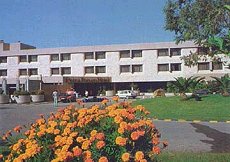 meters from the gateway to Petra, the Petra Forum Guest
House is the perfect place from which to explore this ancient Nabatean capital.
Set in landscaped grounds with panoramic views over the mountains, the Petra
Forum offers visitors excellent facilities, comfort and unmatched hospitality.........From
80$ per room.........(more
details and special rates) meters from the gateway to Petra, the Petra Forum Guest
House is the perfect place from which to explore this ancient Nabatean capital.
Set in landscaped grounds with panoramic views over the mountains, the Petra
Forum offers visitors excellent facilities, comfort and unmatched hospitality.........From
80$ per room.........(more
details and special rates) |
Petra Palace Hotel 3*
Petra Palace Hotel is
fully
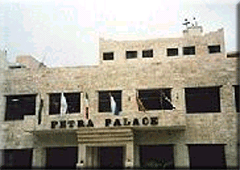 air-conditioned
and has eighty three elegantly furnished guest rooms which overlook the
scenic Petra mountains wile other overlook a beautifully done garden where
the heated swimming pool is located all rooms are air conditioned
and...........From
75$ per room...........(more
details and special rates) air-conditioned
and has eighty three elegantly furnished guest rooms which overlook the
scenic Petra mountains wile other overlook a beautifully done garden where
the heated swimming pool is located all rooms are air conditioned
and...........From
75$ per room...........(more
details and special rates) |
Edom Hotel 3*
The Edom Hotel is an ideal
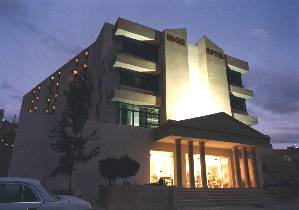 starting
point for your tour of Jordan. From Amman, the capital of Jordan it's about
three driving hours, from Aqaba it's two driving hours to Petra and the Edom
Hotel. The hotel is 200 meters away from the main entrance of Petra.
Featuring 135 air conditioned rooms we offer double, single and
s.......From
75$ per room........
(more
details and special rates) starting
point for your tour of Jordan. From Amman, the capital of Jordan it's about
three driving hours, from Aqaba it's two driving hours to Petra and the Edom
Hotel. The hotel is 200 meters away from the main entrance of Petra.
Featuring 135 air conditioned rooms we offer double, single and
s.......From
75$ per room........
(more
details and special rates) |
Amra Palace Hotel 3*
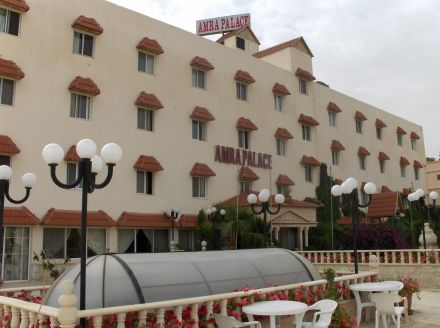 The Three Star Amra Palace Hotel
is wonderfully located at the heart of the city, the hotel is minutes away
from the main shopping areas and the entrance to the ancient city of Petra.
........From
75$ per room..........(more
details and special rates) The Three Star Amra Palace Hotel
is wonderfully located at the heart of the city, the hotel is minutes away
from the main shopping areas and the entrance to the ancient city of Petra.
........From
75$ per room..........(more
details and special rates) |
Petra Inn Hotel 3*
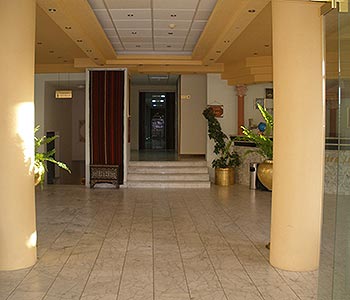 Just few steps away from the
entrance
to the Magnificent Nabatean city of Petra, with Beautiful view of the
red-rose Mountains...........From
75$ per room.........(more
details and special rates) Just few steps away from the
entrance
to the Magnificent Nabatean city of Petra, with Beautiful view of the
red-rose Mountains...........From
75$ per room.........(more
details and special rates) |
Oscar Hotel 3*. ..............From
75$ per room.....(more
details and special rates) ..............From
75$ per room.....(more
details and special rates) |
Silk Road Hotel 3*
Silk road hotel is a
three stars
 hotel
located at the main tourist street and only three~ minute walk from the main
gate to Petra actually you can view the gate from your own room the hotel
and restaurant from a part of a (complex) building which provides several
tourist facilities : car rental taxi service souvenir shops
barber.......From
80$ per room.......(more
details and special rates) hotel
located at the main tourist street and only three~ minute walk from the main
gate to Petra actually you can view the gate from your own room the hotel
and restaurant from a part of a (complex) building which provides several
tourist facilities : car rental taxi service souvenir shops
barber.......From
80$ per room.......(more
details and special rates) |
Al Anbat Hotel 3*
 Alanbat I 3KM far from the
min city of Petra Alanbat II & III are 400 Ms far from the shopping centre and
from Petra..From
70$ per room......(more
details and special rates) Alanbat I 3KM far from the
min city of Petra Alanbat II & III are 400 Ms far from the shopping centre and
from Petra..From
70$ per room......(more
details and special rates) |
Candles Hotel 3*
A very warm
welcome from
 Candles
Hotel in Petra. Candles hotel was established in 1997 located right at the
entrance of the ancient city of the Nabateans. We have made every effort to
bring you the very best in service and facilities. In doing so, we have
given our best thought to .................(more
details and special rates) Candles
Hotel in Petra. Candles hotel was established in 1997 located right at the
entrance of the ancient city of the Nabateans. We have made every effort to
bring you the very best in service and facilities. In doing so, we have
given our best thought to .................(more
details and special rates) |
Sella Hotel 3*
Sella Hotel is a three stars hotel
 located
in the most beautiful location in Wadi Musa overlooking the gorgeous
mountain and valleys of Petra.............(more
details and special rates) located
in the most beautiful location in Wadi Musa overlooking the gorgeous
mountain and valleys of Petra.............(more
details and special rates) |
|
Guest House Crowne Petra Hotel 3* .................(more
details and special rates) |
La Maison Hotel 3* .................(more
details and special rates) .................(more
details and special rates) |
|
Hotels 2* in Petra |
|
Qasr Al Bint Hotel
2* The Qasr Al Bint is a small
family-run hotel in Petra, only 1.5km from the main entrance to the
ancient city. Comfortable guest rooms, friendly service and free
Wi-Fi are all on offer in a convenient city location.
....(more
details and special rates)
|
Valley Stars Inn Hotel 2* Valley Stars Inn is located in the
heart of the historic centre of Wadi Musa City. It is
1.5 km from the main gate of Petra. ............(more
details and special rates) Valley Stars Inn is located in the
heart of the historic centre of Wadi Musa City. It is
1.5 km from the main gate of Petra. ............(more
details and special rates) |
Welcome to Petra
Hidden behind an almost impenetrable barrier of rugged
mountains, the rock-carved city of Petra is full of mysterious charm. The
approach through the cool gloom of the Siq, a long narrow gorge whose steeply
rising sides all but obliterate the sun, provides a dramatic contrast with the
magic to come. Suddenly the gorge opens into a natural square dominated by
Petra's most famous monument, the Khasneh, whose intricately carved facade glows
in the dazzling sun.
More
facades beckon the visitor on until the ancient city gradually unfolds, one
monument leading to the next for kilometer after kilometer. The sheer size of
the city and the quality of beautifully carved facades is staggering and leads
one to reflect on the creativity and industry of the Nabateans who made Petra
their capital more than 2,000 years ago. From their capital at Petra the
Nabateans had established an elaborate network of caravan routes which brought
spices, incense, myrrh, gold, silver and precious stones from India and Arabia,
to be traded onto the west.
network of caravan routes which brought
spices, incense, myrrh, gold, silver and precious stones from India and Arabia,
to be traded onto the west.
From the wealth they acquired, they adorned their city
with palaces, temples and arches. Many that were freestanding have largely
disappeared but many were carved into the rock i.e. the treasury, the monumental
tombs and the high place of sacrifice. These still remain today in a condition
of perfection so staggering that you feel you must have entered a time wrap.
Petra is an enchanting place that captivates and excites the senses. Its
overwhelming size, rich textures and stunning surroundings create an ambiance
almost impossible to describe.
As you set off from the City's entrance gate, at this
stage the valley is quite wide and open. This section is the
approach to the narrow gorge and is know as Bab Es-Siq, gateway of the Siq. The
first monuments you pass are the curious Djinn Blocks, a cluster of three
freestanding rock cubes just to the right of the track.
Continuing along the path you come to the Obelisk Tomb, carved out of the cliff.
At one point the passageway goes from a wide breach to a dark chasm not more
than a few feet across. Suddenly in the space of a few footsteps, you get your
first glimpse of Petra's most fabled achievement, El-Khazneh (the Treasury),
which looms up in the brilliant sunshine, carved from the rock, defiled by man.
At the outer siq's widest point a gully runs abruptly
off to the south. The path takes you to the high place: an ancient Nabatean
sacrificial site with an Altar cut from the rock. For those who can stand the
strenuous climb, the sweeping view of Petra is well worthwhile.
Past the
altar the track continues leading to the garden Tridinium (the garden temple
complex). There are two freestanding colonnades, in front of which are a
remnants of a shrine. Continuing on, one passes dozens of wall niches, before
arriving at the Roman Soldier's Tomb, and a further Triclinium.
Petra has dozens of sacred sites. On a windswept ridge
high above the city, the Nabatean people extolled their gods at the High Place
known as El-Madbah in Arabic. In an area known as the street of facades, many
classical Nabatean ruins can be seen.
The Outer siq makes a sudden turn northwards and leads
to the Roman Theatre which was built in typical
Roman style. The substantial building Qasr El Bint Faroun (Palace of the
Pharoa's daughter'), demonstrates that the Nabateans were capable of creating
freestanding buildings.
Petra's second most spectacular construction after the
treasury is El-Deir (The Monastery). For a feeling of Petra's immensity and the
sheer power of the rock, the trip is essential.
Across from the Qasr El Bint a jumbo of steps lead up
to Petra's Museum. The room housing the small collection is the most monumental
exhibit of all.
Geography of Petra
Pliny the Elder and other writers identify Petra
as the capital of the Nabataeans and the centre of their caravan trade.
Enclosed by towering rocks and watered by a perennial stream, Petra not
only possessed the advantages of a fortress, but controlled the main
commercial routes which passed through it to Gaza in the west, to Bosra
and Damascus in the north, to Aqaba and Leuce Come on the Red Sea, and
across the desert to the Persian Gulf.
Excavations have demonstrated that it was the ability of the Nabataeans
to control the water supply that led to the rise of the desert city,
creating an artificial oasis. The area is visited by flash floods and archaeological evidence demonstrates the Nabataeans controlled these
floods by the use of dams, cisterns and water conduits. These
innovations stored water for prolonged periods of drought, and enabled
the city to prosper from its sale.
archaeological evidence demonstrates the Nabataeans controlled these
floods by the use of dams, cisterns and water conduits. These
innovations stored water for prolonged periods of drought, and enabled
the city to prosper from its sale.
Although in ancient times Petra might have been
approached from the south via Saudi Arabia on a track leading around
Jabal Haroun ("Aaron's Mountain"), across the plain of Petra, or
possibly from the high plateau to the north, most modern visitors
approach the site from the east. The impressive eastern entrance leads
steeply down through a dark, narrow gorge (in places only 3�4 m (9.8�13
ft) wide) called the Siq ("the shaft"), a natural geological
feature formed from a deep split in the sandstone rocks and serving as a
waterway flowing into Wadi Musa. At the end of the narrow gorge stands
Petra's most elaborate ruin, Al Khazneh (popularly known as "the
Treasury"), hewn into the sandstone cliff.
A little further from the Treasury, at the foot of
the mountain called en-Nejr, is a massive theatre, so placed as
to bring the greatest number of tombs within view. At the point where
the valley opens out into the plain, the site of the city is revealed
with striking effect. The amphitheatre has been cut into the hillside
and into several of the tombs during its construction. Rectangular gaps
in the seating are still visible. Almost enclosing it on three sides are
rose-coloured mountain walls, divided into groups by deep fissures, and
lined with knobs cut from the rock in the form of towers.
History of Petra
Evidence suggests that settlements had begun in
and around Petra in the eighteenth dynasty of Egypt (1550-1292 BCE). It
is listed in Egyptian campaign accounts and the Amarna letters as Pel,
Sela or Seir. Though the city was founded relatively late, a sanctuary
existed there since very ancient times. Stations 19 through 26 of the
stations list of Exodus are places associated with Petra. This part of
the country was Biblically assigned to the Horites, the predecessors of
the Edomites. The habits of the original natives may have influenced the
Nabataean custom of burying the dead and offering worship in
half-excavated caves. Although Petra is usually identified with Sela
which means a rock, the Biblical references, refer to it as "the
cleft in the rock", referring to its entrance. 2 Kings xiv. 7 seems to
be more specific. In the parallel passage, however, Sela is understood
to mean simply "the rock" (2 Chr. xxv. 12, see LXX).
On the authority of Josephus (Antiquities of
the Jews iv. 7, 1~ 4, 7) Eusebius and Jerome (Onom. sacr.
286, 71. 145, 9; 228, 55. 287, 94) assert that Rekem was the
native name and Rekem appears in the Dead Sea scrolls as a
prominent Edom site most closely describing Petra and associated with
Mount Seir. But in the Aramaic versions Rekem is the name of Kadesh,
implying that Josephus may have confused the two places. Sometimes the
Aramaic versions give the form Rekem-Geya which recalls the name
of the village El-ji, southeast of Petra. The Semitic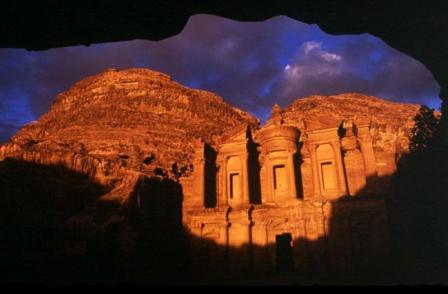 name of the city, if not Sela, remains unknown. The passage in Diodorus
Siculus (xix. 94�97) which describes the expeditions which Antigonus
sent against the Nabataeans in 312 BCE is understood to throw some light
upon the history of Petra, but the "petra" referred to as a natural
fortress and place of refuge cannot be a proper name and the description
implies that the town was not yet in existence.
name of the city, if not Sela, remains unknown. The passage in Diodorus
Siculus (xix. 94�97) which describes the expeditions which Antigonus
sent against the Nabataeans in 312 BCE is understood to throw some light
upon the history of Petra, but the "petra" referred to as a natural
fortress and place of refuge cannot be a proper name and the description
implies that the town was not yet in existence.
The only place in Petra where the name "Rekem"
occurs was in the rock wall of the Wadi Musa opposite the entrance to
the Siq. About twenty years ago the Jordanians built a bridge over the
wadi and this inscription was buried beneath tons of concrete.
More satisfactory evidence of the date of the
earliest Nabataean settlement may be obtained from an examination of the
tombs. Two types have been distinguished: the Nabataean and the
Greco-Roman. The Nabataean type starts from the simple pylon-tomb with a
door set in a tower crowned by a parapet ornament, in imitation of the
front of a dwelling-house. Then, after passing through various stages,
the full Nabataean type is reached, retaining all the native features
and at the same time exhibiting characteristics which are partly
Egyptian and partly Greek. Of this type there exist close parallels in
the tomb-towers at el-I~ejr in north Arabia, which bear long Nabataean
inscriptions and supply a date for the corresponding monuments at Petra.
Then comes a series of tombfronts which terminate in a semicircular
arch, a feature derived from north Syria. Finally come the elaborate
fa�ades copied from the front of a Roman temple; however, all traces of
native style have vanished. The exact dates of the stages in this
development cannot be fixed. Strangely, few inscriptions of any length
have been found at Petra, perhaps because they have perished with the
stucco or cement which was used upon many of the buildings. The simple
pylon-tombs which belong to the pre-Hellenic age serve as evidence for
the earliest period. It is not known how far back in this stage the
Nabataean settlement goes, but it does not go back farther than the 6th
century BCE.
A period follows in which the dominant
civilization combines Greek, Egyptian and Syrian elements, clearly
pointing to the age of the Ptolemies. Towards the close of the 2nd
century BCE, when the Ptolemaic and Seleucid kingdoms were equally
depressed, the Nabataean kingdom came to the front. Under Aretas III
Philhellene, (c.85�60 BCE), the royal coins begin. The theatre was
probably excavated at that time, and Petra must have assumed the aspect
of a Hellenistic city. In the reign of Aretas IV Philopatris, (9 BCE�40
CE), the fine tombs of the el-I~ejr [?] type may be dated, and perhaps
also the great High-place.
Roman rule in Petra
In 106 CE, when Cornelius Palma was
governor of Syria, that part of Arabia under the rule of Petra
was absorbed into the Roman Empire as part of Arabia Petraea,
becoming capital. The native dynasty came to an end. But the
city continued to flourish. A century later, in the time of
Alexander Severus, when the city was at the height of its
splendor, the issue of coinage comes to an end. There is no more
building of sumptuous tombs, owing apparently to some sudden
catastrophe, such as an invasion by the neo-Persian power under
the Sassanid Empire. Meanwhile, as Palmyra 130�270) grew in
importance and attracted the Arabian trade away from Petra, the
latter declined. It seems, however, to have lingered on as a
religious centre. A Roman road was constructed at the site.
Epiphanius of Salamis (c.315�403) writes that in his time a
feast was held there on December 25 in honor of the virgin
Khaabou (Chaabou) and her offspring Dushara (Haer. 51).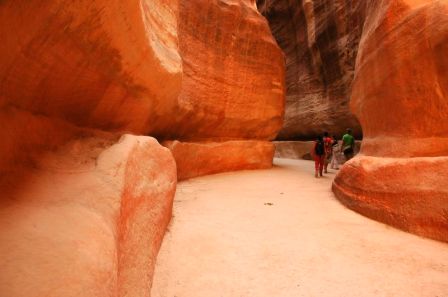
Religion in Petra
The Nabataeans worshipped the Arab gods
and goddesses of the pre-Islamic times as well as a few of their
deified kings. One, Obodas I, was deified after his death.
Dushara was the main male god accompanied by his female trinity:
Al-�Uzz�, Allat and Manāt. Many statues carved in the rock
depict these gods and goddesses.
The Monastery, Petra's largest monument, dates from the 1st
century BCE. It was dedicated to Obodas I and is believed to be
the symposium of Obodas the god. This information is inscribed
on the ruins of the Monastery (the name is the translation of
the Arabic "Ad Deir").
Christianity found its way to Petra in
the 4th century CE, nearly 500 years after the establishment of
Petra as a trade center. Athanasius mentions a bishop of Petra (Anhioch.
10) named Asterius. At least one of the tombs (the "tomb with
the urn"?) was used as a church. An inscription in red paint
records its consecration "in the time of the most holy bishop
Jason" (447). After the Islamic conquest of 629�632 Christianity
in Petra, as of most of Arabia, gave way to Islam. During the
First Crusade Petra was occupied by Baldwin I of the Kingdom of
Jerusalem and formed the second fief of the barony of Al Karak
(in the lordship of Oultrejordain) with the title Ch�teau de
la Val�e de Moyse or Sela. It remained in the hands of the
Franks until 1189. It is still a titular see of the Catholic
Church.
According to Arab tradition, Petra is
the spot where Moses struck a rock with his staff and water came
forth, and where Moses' brother, Aaron, is buried, at Mount Hor,
known today as Jabal Haroun or Mount Aaron. The Wadi Musa or "Wadi
of Moses" is the Arab name for the narrow valley at the head of
which Petra is sited. A mountaintop shrine of Moses' sister
Miriam was still shown to pilgrims at the time of Jerome in the
4th century, but its location has not been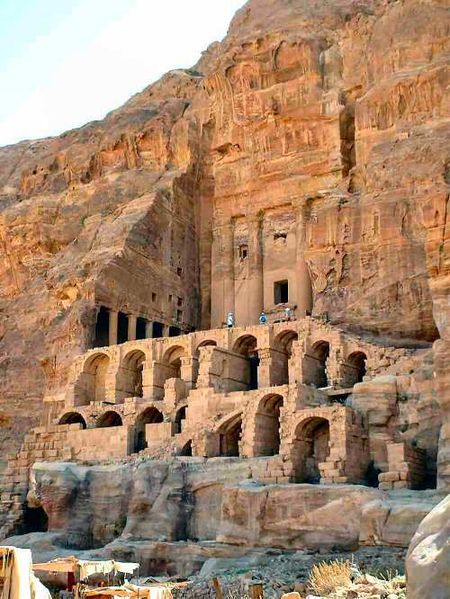 identified since.
identified since.
Decline of Petra
Petra declined rapidly under Roman rule,
in large part from the revision of sea-based trade routes. In
363 an earthquake destroyed many buildings, and crippled the
vital water management system. The ruins of Petra were an object
of curiosity in the Middle Ages and were visited by Sultan
Baibars of Egypt towards the end of the 13th century. The first
European to describe them was Johann Ludwig Burckhardt in 1812.
Because the structures weakened with age,
many of the tombs became vulnerable to thieves, and many
treasures were stolen.
Threats to Petra
The site suffers from a host of threats, including
collapse of ancient structures, erosion due to flooding and improper rainwater
drainage, weathering from salt upwelling, improper restoration of ancient
structures, and unsustainable tourism. The latter has increased substantially
ever since the site received widespread media coverage in 2007 during the
controversial New Seven Wonders of the World Internet and cell phone campaign,
started by a private corporation.
Petra today
On December 6, 1985, Petra was designated a World
Heritage Site.In 2006 the design of a
Visitor Centre began. The Jordan Times reported in December 2006
that 59,000 people visited in the two months October and November 2006,
25% fewer than the same period in the previous year.
Russian
French
Spanish
German
Italian
Dutch
Portuguese
Norwegian
Lebanon Hotels Syria
Hotels Lebanon
Hotels Lebanon
Hotels Jordan
Hotels Lebanon
Hotels Lebanon
Hotels Lebanon
Hotels Lebanon
Hotels Lebanon
Hotels Lebanon
Hotels Lebanon
Hotels Jordan
Hotels Jordan
Hotels Jordan
Hotels Jordan
Hotels Jordan
Hotels Lebanon Hotels
Lebanon Hotels
Syria Hotels
 archaeological evidence demonstrates the Nabataeans controlled these
floods by the use of dams, cisterns and water conduits. These
innovations stored water for prolonged periods of drought, and enabled
the city to prosper from its sale.
archaeological evidence demonstrates the Nabataeans controlled these
floods by the use of dams, cisterns and water conduits. These
innovations stored water for prolonged periods of drought, and enabled
the city to prosper from its sale.
 The Petra Marriott
Hotel is
situated
on a steep sloping site overlooking the dramatic and picturesque Petra
valley...........From
130$ per room.......
The Petra Marriott
Hotel is
situated
on a steep sloping site overlooking the dramatic and picturesque Petra
valley...........From
130$ per room.......
 The M�venpick Resort is located
directly at the entrance to the city of Petra. Easily reached by bus or car
from Amman or Aqaba. The hotel has 183 rooms (including 2 royal suites, 4
executive suites and..........From
145$ per room................
The M�venpick Resort is located
directly at the entrance to the city of Petra. Easily reached by bus or car
from Amman or Aqaba. The hotel has 183 rooms (including 2 royal suites, 4
executive suites and..........From
145$ per room................ An authentic
early Jordanian
village houses; 130 guest houses and a royal suite, all with private bathrooms,
air conditioned and heated and tastefully furnished to compliment the village
style and setting. All rooms will feature satellite TV, direct dial telephone,
mini-bar; hairdryers, and room safes........From
100$ per room.........
An authentic
early Jordanian
village houses; 130 guest houses and a royal suite, all with private bathrooms,
air conditioned and heated and tastefully furnished to compliment the village
style and setting. All rooms will feature satellite TV, direct dial telephone,
mini-bar; hairdryers, and room safes........From
100$ per room......... Grand Mercure Petra Beit Zaman, opened September, 2000, is a
renovated authentic XIXth century village, known as Khirbet Al Nawafleh, in Wadi
Musa, transformed into this deluxe resort.
The refurbishment of the old village houses was carried out in keeping with the
original architectural style while providing the luxury and comfort required by
the modern travelers...From
100$ per room..........
Grand Mercure Petra Beit Zaman, opened September, 2000, is a
renovated authentic XIXth century village, known as Khirbet Al Nawafleh, in Wadi
Musa, transformed into this deluxe resort.
The refurbishment of the old village houses was carried out in keeping with the
original architectural style while providing the luxury and comfort required by
the modern travelers...From
100$ per room.......... on a
hillside at 1400 meter altitude, with spectacular view over the great rift
valley. 10 minutes from the entrance of city of Petra, the capital of
ancient Nabateans is a world treasure, Petra is a marriage of natural and
man-made wonders on an awsome scale, an entire city was carved out of the
highly-colored mountains .........From
100$ per room.........
on a
hillside at 1400 meter altitude, with spectacular view over the great rift
valley. 10 minutes from the entrance of city of Petra, the capital of
ancient Nabateans is a world treasure, Petra is a marriage of natural and
man-made wonders on an awsome scale, an entire city was carved out of the
highly-colored mountains .........From
100$ per room......... Situated just 100
meters
from the gateway to Petra, the Crown Plaza is the perfect place from which
to explore this ancient Nabatean capital. Set in landscaped grounds with
panoramic views over the mountains, the Petra Forum offers visitors
excellent facilities, comfort and unmatched hospitality.........From
115$ per room.........
Situated just 100
meters
from the gateway to Petra, the Crown Plaza is the perfect place from which
to explore this ancient Nabatean capital. Set in landscaped grounds with
panoramic views over the mountains, the Petra Forum offers visitors
excellent facilities, comfort and unmatched hospitality.........From
115$ per room......... star hotel in Petra - Jordan,
offering an incomparable birds eye-view of the marvelous rock-carved rose red
city of Petra and the fascinating landscape surrounding it. Located at the mountain peak with cliff-top view of
this magical and mystical place, directly facing Mount Hor with a spectacular
view of Aaron�s Tomb, makes staying here truly an unforgettable once in a life
time experience.........From
100$ per room..........
star hotel in Petra - Jordan,
offering an incomparable birds eye-view of the marvelous rock-carved rose red
city of Petra and the fascinating landscape surrounding it. Located at the mountain peak with cliff-top view of
this magical and mystical place, directly facing Mount Hor with a spectacular
view of Aaron�s Tomb, makes staying here truly an unforgettable once in a life
time experience.........From
100$ per room.......... is situated
on a hill overlooking Petra with breathtaking views of mountain, plain and sea,
only 5 minutes drive from the entrance to the ancient city of Petra. Located
just 200 meters from the resort centre of Petra means guests are within easy
reach of all amenities........From
95$ per room.......
is situated
on a hill overlooking Petra with breathtaking views of mountain, plain and sea,
only 5 minutes drive from the entrance to the ancient city of Petra. Located
just 200 meters from the resort centre of Petra means guests are within easy
reach of all amenities........From
95$ per room....... Welcome to
the heart of one of
the ancient civilizations in the land of Jordan, within the Kings' Highway,
inhabited by numerous empires for several thousands of years. The Golden Tulip
Kings' Way is located next to the famous Moses Springs, 4 km from the
amazing rose-red city of Petra. A modern 4-Star hotel, we are equipped
with..........From
125$ per room........
Welcome to
the heart of one of
the ancient civilizations in the land of Jordan, within the Kings' Highway,
inhabited by numerous empires for several thousands of years. The Golden Tulip
Kings' Way is located next to the famous Moses Springs, 4 km from the
amazing rose-red city of Petra. A modern 4-Star hotel, we are equipped
with..........From
125$ per room........ meters from the gateway to Petra, the Petra Forum Guest
House is the perfect place from which to explore this ancient Nabatean capital.
Set in landscaped grounds with panoramic views over the mountains, the Petra
Forum offers visitors excellent facilities, comfort and unmatched hospitality.........From
80$ per room.........
meters from the gateway to Petra, the Petra Forum Guest
House is the perfect place from which to explore this ancient Nabatean capital.
Set in landscaped grounds with panoramic views over the mountains, the Petra
Forum offers visitors excellent facilities, comfort and unmatched hospitality.........From
80$ per room......... air-conditioned
and has eighty three elegantly furnished guest rooms which overlook the
scenic Petra mountains wile other overlook a beautifully done garden where
the heated swimming pool is located all rooms are air conditioned
and...........From
75$ per room...........
air-conditioned
and has eighty three elegantly furnished guest rooms which overlook the
scenic Petra mountains wile other overlook a beautifully done garden where
the heated swimming pool is located all rooms are air conditioned
and...........From
75$ per room........... starting
point for your tour of Jordan. From Amman, the capital of Jordan it's about
three driving hours, from Aqaba it's two driving hours to Petra and the Edom
Hotel. The hotel is 200 meters away from the main entrance of Petra.
Featuring 135 air conditioned rooms we offer double, single and
s.......From
75$ per room........
starting
point for your tour of Jordan. From Amman, the capital of Jordan it's about
three driving hours, from Aqaba it's two driving hours to Petra and the Edom
Hotel. The hotel is 200 meters away from the main entrance of Petra.
Featuring 135 air conditioned rooms we offer double, single and
s.......From
75$ per room........
 The Three Star Amra Palace Hotel
is wonderfully located at the heart of the city, the hotel is minutes away
from the main shopping areas and the entrance to the ancient city of Petra.
........From
75$ per room..........
The Three Star Amra Palace Hotel
is wonderfully located at the heart of the city, the hotel is minutes away
from the main shopping areas and the entrance to the ancient city of Petra.
........From
75$ per room.......... Just few steps away from the
entrance
to the Magnificent Nabatean city of Petra, with Beautiful view of the
red-rose Mountains...........From
75$ per room.........
Just few steps away from the
entrance
to the Magnificent Nabatean city of Petra, with Beautiful view of the
red-rose Mountains...........From
75$ per room......... ..............From
75$ per room.....
..............From
75$ per room..... hotel
located at the main tourist street and only three~ minute walk from the main
gate to Petra actually you can view the gate from your own room the hotel
and restaurant from a part of a (complex) building which provides several
tourist facilities : car rental taxi service souvenir shops
barber.......From
80$ per room.......
hotel
located at the main tourist street and only three~ minute walk from the main
gate to Petra actually you can view the gate from your own room the hotel
and restaurant from a part of a (complex) building which provides several
tourist facilities : car rental taxi service souvenir shops
barber.......From
80$ per room.......
 Candles
Hotel in Petra. Candles hotel was established in 1997 located right at the
entrance of the ancient city of the Nabateans. We have made every effort to
bring you the very best in service and facilities. In doing so, we have
given our best thought to .................
Candles
Hotel in Petra. Candles hotel was established in 1997 located right at the
entrance of the ancient city of the Nabateans. We have made every effort to
bring you the very best in service and facilities. In doing so, we have
given our best thought to ................. located
in the most beautiful location in Wadi Musa overlooking the gorgeous
mountain and valleys of Petra.............
located
in the most beautiful location in Wadi Musa overlooking the gorgeous
mountain and valleys of Petra............. .................(more
details and special rates)
.................(more
details and special rates) Valley Stars Inn is located in the
heart of the historic centre of Wadi Musa City. It is
1.5 km from the main gate of Petra. ............
Valley Stars Inn is located in the
heart of the historic centre of Wadi Musa City. It is
1.5 km from the main gate of Petra. ............ network of caravan routes which brought
spices, incense, myrrh, gold, silver and precious stones from India and Arabia,
to be traded onto the west.
network of caravan routes which brought
spices, incense, myrrh, gold, silver and precious stones from India and Arabia,
to be traded onto the west. name of the city, if not Sela, remains unknown. The passage in Diodorus
Siculus (xix. 94�97) which describes the expeditions which Antigonus
sent against the Nabataeans in 312 BCE is understood to throw some light
upon the history of Petra, but the "petra" referred to as a natural
fortress and place of refuge cannot be a proper name and the description
implies that the town was not yet in existence.
name of the city, if not Sela, remains unknown. The passage in Diodorus
Siculus (xix. 94�97) which describes the expeditions which Antigonus
sent against the Nabataeans in 312 BCE is understood to throw some light
upon the history of Petra, but the "petra" referred to as a natural
fortress and place of refuge cannot be a proper name and the description
implies that the town was not yet in existence.
 identified since.
identified since.